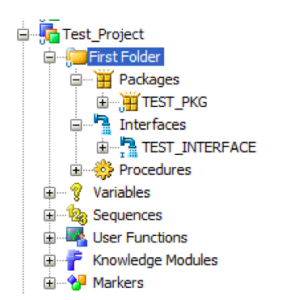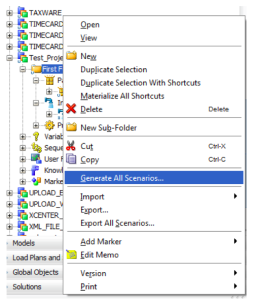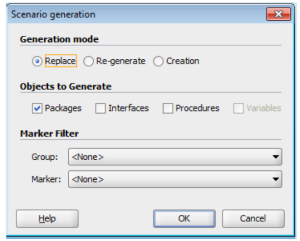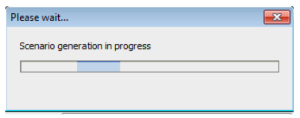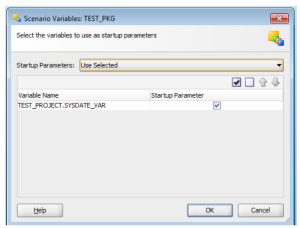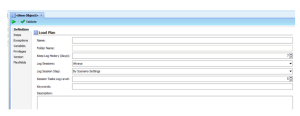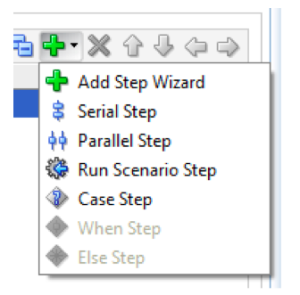Hopefully everyone has been enjoying my many post on Oracle Data Integrator (ODI), again its starting to become one of my favorite ETL or E-LT software solutions. With that being said, I wanted to continue my discussions with ODI and create a post showing you all how to create a ODI scenario and load plan.
So what is a ODI scenario and load plan you ask? When a component such as a ODI interface or package has been created and tested, you can generate the scenario corresponding its actual state. Now Oracle defines the scenario code (the language generated) as the frozen competent, and all subsequent modifications of the components which contributed to creating it will not change it in any way.
It is possible to generate scenarios for packages, procedures, interfaces or variables. Scenarios generated for procedures, interfaces or variables are single step scenarios that execute the procedure, interface or refresh the variable[1].
Now an ODI load plan load plan is an executable object in ODI that can contain a hierarchy of steps that can be executed conditionally, in parallel or in series. The leaves of this hierarchy are Scenarios. Packages, interfaces, variables, and procedures can be added to Load Plans for executions in the form of scenarios[2].
Hopefully that has given you a better understanding of what a ODI scenario and load plan is and how they are used. So hopefully you see the benefit in its use and in future posts I will discuss the different type of ODI environments in which, within executable ODI repository you only are allowed to have ODI scenario and load plans. But then that is another post, so lets get started on how we can create our very own ODI scenario and load plan.
Now in our previous posts I have shown you how to create and ODI interface and a ODI package. Now to create a ODI scenario first locate the folder where the interface or package you would want to convert into a ODI scenario.
Once you have located the folder, highlight the folder and right mouse click. You will see a few options. Locate the “Generate All Scenarios” and click the following option.
A popup will appear in which you will be asked to select a few options.
- Replace, Re-generate, and Creation
o Here you can either replace an existing scenario, re-generate a scenario due to updates and changes or create a new scenario.
- Object to Generate
o Here you have options on what ODI components in which you would want to convert to a ODI scenario.
- Marker Filter
o You can add the following scenario into a group and add a marker.
For our example you will select “Creation” for your generation mode and select “Packages” for objects to generate. For the marker filter options you will leave this as “None.”
Once you have selected the following options, click “OK.”
Your scenario should be generating.
Guide to Oracle Cloud: 5 Steps to Ensure a Successful Move to the Cloud
Explore key considerations, integrating the cloud with legacy applications and challenges of current cloud implementations.
Now in my previous post I added a variable to my ODI package. If you do have a ODI variable within your package, the scenario variables option will pop up asking you the startup parameter. Leave the following checked and click “Ok.”
You should not have received a pop up letting you know your scenario has been created.
In addition, you can validate your scenario has been created by going to the “Load Plans and Scenarios” tab and find your scenario.
Please note: You can also execute your scenario similar to a ODI interface or package.
Now that we have our ODI scenario we can move forward and create an ODI load plan.
To create your ODI load plan you will need to locate the “Load Plans and Scenarios” tab. There on the left corner your will finder a folder with a drop down. Select the following. A few options will appear in which you will select “New Load Plan.”
Once you have click on “New Load Plan” option you will not be able to create your load plan.
First you will need to enter a ODI load plan name. Then next enter in the appropriate ODI load plan settings that fit your needs. In this example I will use the Oracle ODI default settings.
Now that you have entered the basic ODI load plan information click on the “Steps” tab on the left hand corner.
Here you can add your scenario or scenarios in your load plan. To add the following, click on the “Green +” on the top right hand corner.
Here you can add your scenario as a serial step, parallel step, or case step. In addition, you can run a specific scenario step. But here in our example select “Serial Step.”
Once you have added the “Serial Step” locate your scenario within the “Load Plans and Scenario” tab and drag it into your load plan.
Once you have dragged your scenario to your load plan make sure you save.
Now another great thing you can add to your load plan our expectations in which you can add in the “Exceptions” tab.
Now that you have created your ODI load plan you can execute the following load plan to make sure everything is working successfully. Please stay tuned, as tomorrow I will be dropping a new post showing you how to schedule your ODI load. In addition, if you are looking for more information on ODI scenarios and load plans, please visit the following sites.
Introduction to ODI Load Plans
References:
[1] http://docs.oracle.com/cd/E23943_01/integrate.1111/e12643/scenarios.htm
[2] http://docs.oracle.com/cd/E28271_01/integrate.1111/e12643/loadplans.htm
